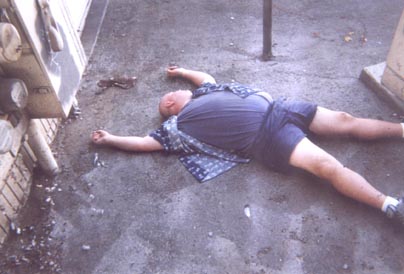
What's the very FIRST thing you have to do?
Granting you're the "Good Samaritan" ready-and-willing type, let's play the scenario game: so you're out walking with friends/family or significant other and having a good time. Turning to a corner, you see what appears to be a man lying on the street. Drunk? Maybe. Injured and unconscious? Possibly. Instinctively, you want to come over to find out what happened and how you can help the poor man, which you do.
So after deciding to ask your friend or relative to call for help with his/her cell phone or trying to revive him or doing a primary survey assessment while mentally going through your CPR drills should they come into play, which task actually comes first?
So after deciding to ask your friend or relative to call for help with his/her cell phone or trying to revive him or doing a primary survey assessment while mentally going through your CPR drills should they come into play, which task actually comes first?
Sometimes in our overzealousness to help out, we forget that we might become victims ourselves. This could very much arise from the fact that we didn't survey the area and check on how safe or secure the situation really is. How safe was it actually to approach the victim? In failing to do so, me might become part of the problem instead of the solution.
Let's go back to the picture above. It's very easy to "tunnel-vision" and zero-in only on the victim, which actually happens in an emergency or a hi-stress situation so its best to prepare for it. In the perimeter, are there hidden or unseen debris, obstacles or objects which may hurt/harm/hinder you or the victim more? How large is the area you're going to position yourself in? What's on the other side of the corner? Is the ground level, slippery or covered with any material (part of the consideration if and when maneuvering or evacuating becomes necessary).
This becomes even more relevant if we consider a wreckage-type accidents like a vehicle head-on collision or a plane crash. An exploding fuel tank becomes a real consideration then! How about a car dangling precariously off the side of a cliff or elevated road? Do you think your added weight or motion might cause it to fall altogether?
This is an important lesson I learned as well. Sometime back when I was undergoing the Red Cross SFA-BLS training (Standard First Aid and Basic Life Support, a five-day course that I encourage you to take should you have the opportunity), during the mass casualty scenario exercise, everyone rushed out of the building premises to a specific area outside where a number of simulated "victims " were located. On the threshold of the gate however, I was able to stop for about half a second and do a wider field-view of the area. Fortunately I was able to spot a lone "victim" who was partially obscured since she was lying next to a vehicle. Looking back, if I hadn't done that short stop, she would've probably been missed and left there because of all the simulated confusion, panic and greater concentration of victims/casualties somewhere else.
Survey the area first!Let's go back to the picture above. It's very easy to "tunnel-vision" and zero-in only on the victim, which actually happens in an emergency or a hi-stress situation so its best to prepare for it. In the perimeter, are there hidden or unseen debris, obstacles or objects which may hurt/harm/hinder you or the victim more? How large is the area you're going to position yourself in? What's on the other side of the corner? Is the ground level, slippery or covered with any material (part of the consideration if and when maneuvering or evacuating becomes necessary).
This becomes even more relevant if we consider a wreckage-type accidents like a vehicle head-on collision or a plane crash. An exploding fuel tank becomes a real consideration then! How about a car dangling precariously off the side of a cliff or elevated road? Do you think your added weight or motion might cause it to fall altogether?
This is an important lesson I learned as well. Sometime back when I was undergoing the Red Cross SFA-BLS training (Standard First Aid and Basic Life Support, a five-day course that I encourage you to take should you have the opportunity), during the mass casualty scenario exercise, everyone rushed out of the building premises to a specific area outside where a number of simulated "victims " were located. On the threshold of the gate however, I was able to stop for about half a second and do a wider field-view of the area. Fortunately I was able to spot a lone "victim" who was partially obscured since she was lying next to a vehicle. Looking back, if I hadn't done that short stop, she would've probably been missed and left there because of all the simulated confusion, panic and greater concentration of victims/casualties somewhere else.





No comments:
Post a Comment